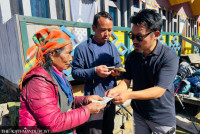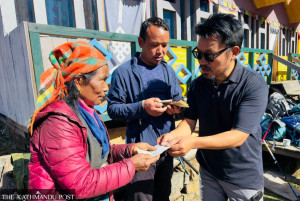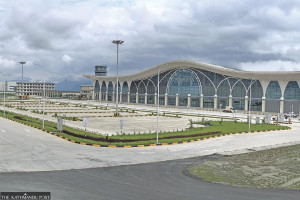Koshi Province
A Bhojpur village faces the wrath of climate change
Hatuwagadhi’s once fertile land that nourished generations is now at risk of becoming a wasteland, and with it, the livelihoods of many families.
Bidhya Rai
On a recent morning, Anita Rai made her way down the steep hill from Kattike Bisauni Chowk, in Hatuwagadhi Rural Municipality of Bhojpur district, carrying bags of rice on her back. Just a decade ago, her family would have been collecting rice directly from their own fields. In the heart of Hatuwagadi, a bustling administrative and commercial hub of the area, rice traders now transport goods via tractor to the market, and locals like Anita are left to carry such goods on their backs to their residences.
“Once, we relied on our crops for sustenance,” Anita recalls. “We grew rice, maize, millet, pulses, and seasonal vegetables. We raised cows and buffaloes for milk and dairy products, and we only had to buy a few items like salt, oil, and sugar when needed.”
For years, families like Anita’s in ward 2 of Hatuwagadi, in the southern part of Bhojpur, have lived off traditional agriculture. The village was once a place of peace, with a close-knit community, the sight of the snow-capped Kanchenjunga range in the distance, and a mild climate. But recently, things have started to change drastically.
The village, situated about 1,350 to 1,450 metres above sea level, has been facing the adverse effects of climate change. Shifting rainfall patterns and prolonged droughts have led to decreased agricultural productivity. Traditionally, maize would be sown by the end of April, and rice transplanted by mid-July, but this routine is now being disrupted by unpredictable weather. For example, there has been less rain at crucial times, leading to poor rice yields, where husks grow instead of grains.
Many locals have begun abandoning rice farming since 2013. Fields that once thrived with crops have become overgrown with shrubs and brush. Some villagers have left their fields fallow due to persistent crop damage caused by pests and changing weather patterns.
Maize, another staple crop in Hatuwagadi, is also being ravaged by the drought. Ram Prasad Rai, a 61-year-old local farmer, explains, “For the past four to five years, drought has affected our maize, and pests have been eating away at it from root to leaf. We can no longer rely on it.”
The local economy is feeling the strain. “Every year, we have to spend around 40,000 rupees for rice,” Gita Rai, another farmer in the locality, says. This has become a common reality for many families, who once grew enough rice for the entire year but now find themselves purchasing food for survival. “The rise in pest infestations in fruits and vegetables has made it necessary to use pesticides, adding further financial burden to farmers,” she added.
Hatuwagadi is not the only victim of this havoc caused by the changing climatic patterns and climate change.The “National Climate Change Survey 2022” published by the National Statistics Office, 65.4 percent of households across Nepal have reported experiencing droughts, and over 50 percent have noticed a rise in crop diseases. Additionally, 87 percent of the respondents said they have observed a change in rainfall patterns.

For Anita’s family, this means relying on maize and rice crops that no longer sustain them. “We have to spend Rs100,000 to Rs150,000 on rice and maize every year,” Anita explains. Her husband works as a migrant labourer in India, while she struggles to manage the household, send children to school, and take care of the farm. It’s been six to seven years of this relentless routine.
This rising burden of climate-induced food insecurity also highlights the increasing role women play in managing the household while their male relatives work abroad. “In the past, the village was vibrant, with men and women working together. Now, most men leave for foreign jobs because farming no longer provides enough for the family,” says Bichari Thapa, the ward chair.
Since 2004, Hatuwagadi has seen some development, such as road and electricity expansion. However, these improvements are overshadowed by the ever-growing problem of drought, water scarcity, and a decline in agricultural productivity. “Once, the village was filled with life, but now, people from six or seven different settlements rarely stay in their homes anymore,” says Deependra Thapa, another victim of the nature-induced havoc.
The struggle in Hatuwagadi is a stern warning of the far-reaching consequences of climate change. Manish Raj Pandey, head of the Climate Change Section at the National Trust for Nature Conservation, the region is increasingly affected by erratic weather patterns—prolonged droughts followed by flash floods and landslides. These events are depleting soil fertility and increasing pest infestations, all of which have dire consequences for food production.
The longer-term consequences of these disruptions are not yet fully clear, but the immediate impacts are undeniable. As roads have improved and access to markets has increased, the forest, once rich with life and resources, is being cleared for timber. This has created some short-term income but also raises concerns about future landslides and erosion.
“The expansion of roads and illegal timber trade is causing more problems,” says a local under anonymity. “When the land dries up, water sources also dry up. And once the forest is gone, there’s no turning back.”
As climate change continues to disrupt life in Hatuwagadi, the struggle for survival becomes even more challenging. The once fertile land that nourished generations is now at risk of becoming a wasteland, and with it, the livelihoods of many rural families.




 16.12°C Kathmandu
16.12°C Kathmandu















